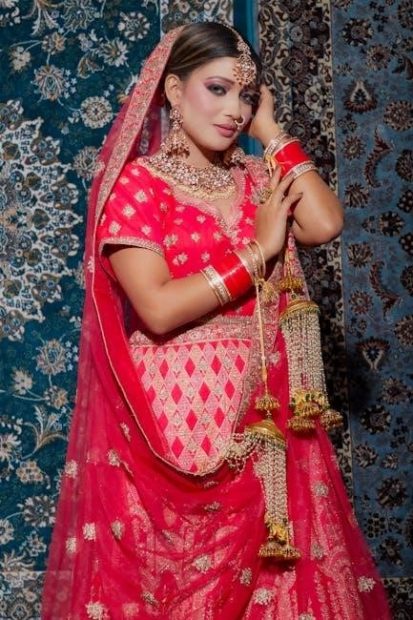Indian bangles are a timeless accessory, with sizes ranging from 2.4 to 2.8 inches, catering to small, medium, and large wrists. The right size ensures comfort and style, making it essential to measure accurately. Standard sizes vary, but 2.6 inches is often the most popular choice.
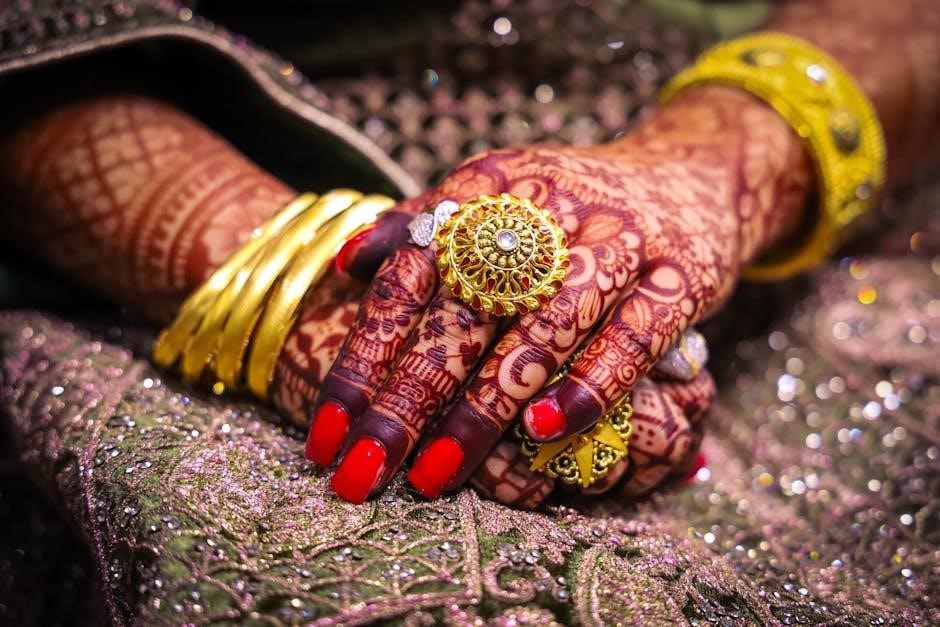
1.1 Why Bangle Size Matters
Bangle size is crucial for both comfort and aesthetics. A bangle that is too tight may cause discomfort, while one that is too loose can slip off easily. Proper sizing ensures the bangle stays securely on the wrist without restricting movement. Indian bangles, often worn in multiples, require precise sizing to maintain a balanced look. The standard sizes, such as 2.4, 2.6, and 2.8 inches, cater to small, medium, and large wrists, respectively. Measuring the inner diameter of an existing bangle or using a size chart can help determine the ideal fit. Ill-fitting bangles can detract from their decorative appeal, making size selection essential for enhancing the overall style. Whether worn alone or stacked, the right size ensures a polished and elegant appearance. Thus, understanding and choosing the correct bangle size is vital for comfort and visual appeal.
1.2 How to Measure Your Wrist for Bangles
Measuring your wrist accurately is essential to find the perfect bangle size. To begin, wrap a flexible measuring tape or a strip of paper around the thinnest part of your wrist, just above the wrist bone. Ensure the tape is snug but not too tight. If using a paper strip, mark the point where it overlaps, then measure the length with a ruler. This measurement will give you your wrist circumference. Next, compare this measurement to a standard bangle size chart. Common sizes include 2.4, 2.6, and 2.8 inches, corresponding to small, medium, and large. For an accurate fit, consider whether you prefer a snug or loose fit, as this may influence your size choice. Additionally, if you already own a bangle that fits well, measure its inner diameter to match it with the size chart. This method ensures a precise fit, whether you’re purchasing online or in-store, and helps you select bangles that complement your wrist perfectly.
1.3 Standard Indian Bangle Sizes
Standard Indian bangle sizes are typically categorized into small, medium, and large, with specific measurements to ensure a proper fit. The most common sizes range from 2.4 to 2.8 inches in diameter, corresponding to the inner circumference of the bangle. Small sizes, usually around 2.4 inches, are ideal for slender wrists, while medium sizes (2.6 inches) suit average wrist sizes. Larger wrists typically require a 2.8-inch bangle for comfort. Some designers also offer extra-small or extra-large sizes, catering to a wider range of wrist sizes. It’s important to note that sizes may vary slightly depending on the region or designer, so referring to a size chart is recommended. When selecting a size, consider whether you prefer a snug fit or a slightly loose one, as this can influence your choice. Additionally, some bangles are adjustable, offering flexibility for different wrist sizes. By understanding standard sizes, you can make informed decisions when purchasing bangles, ensuring a comfortable and stylish fit.
Choosing the Right Bangle Size
Selecting the right bangle size involves considering wrist measurement, personal comfort, and desired fit. Opt for a size that allows easy movement without being too loose. Factors like occasion, design, and material thickness also influence the choice. Always refer to a size chart for accuracy.
2.1 Factors to Consider When Selecting a Size
When choosing the right bangle size, several factors come into play to ensure a perfect fit. First, consider your wrist measurement, as this is the foundation for selecting the correct size. Personal comfort is another crucial aspect; some prefer a snug fit, while others like their bangles to be slightly loose. The occasion also plays a role, as bangles for formal events may require a different size or style compared to casual wear. Additionally, the thickness of the bangle material matters, as thicker bangles may need a slightly larger size for comfort. Lastly, the design and ornaments on the bangle can affect how it sits on the wrist, so it’s important to balance aesthetics with practicality. By evaluating these factors, you can make an informed decision that ensures both style and comfort.
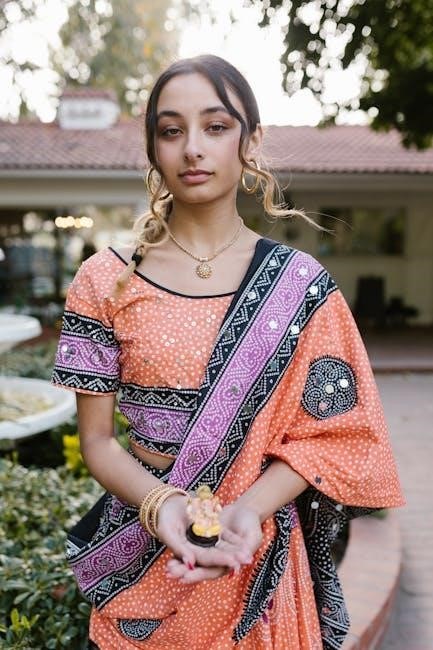
2.2 Understanding Fitting Preferences
Understanding your fitting preferences is essential when selecting the right bangle size. Fitting preferences vary from person to person and are influenced by personal comfort, lifestyle, and the occasion. Some individuals prefer their bangles to fit snugly, ensuring they stay in place securely, while others opt for a looser fit for ease of movement and comfort. The choice between a tight or loose fit also depends on the type of bangle and its design. For instance, delicate or ornate bangles might require a slightly tighter fit to avoid slipping, whereas thicker or statement bangles may look better with a more relaxed fit. Additionally, cultural or regional preferences can influence fitting choices, as some communities traditionally favor tighter bangles, while others prefer a more casual, loose style. It’s important to consider how often you plan to wear the bangles and whether they will be paired with other jewelry. By aligning your fitting preferences with your lifestyle and personal style, you can ensure a comfortable and flattering look. This step is crucial for making the right choice from a bangle size chart.
2.3 Using a Bangle Size Chart
Using a bangle size chart is a practical way to determine the perfect fit for your wrist. These charts typically provide a range of sizes, often categorized as small, medium, or large, and correspond to specific wrist measurements. To use the chart effectively, start by measuring your wrist accurately using a flexible tape measure or a string. Wrap it around the narrowest part of your wrist, keeping it straight, and note the measurement in inches or centimeters. Match this measurement to the size chart to find your ideal bangle size. Many charts also include options for snug, standard, or loose fits, allowing you to choose based on your comfort and style preferences. For example, if your wrist measures 6.5 inches, you might opt for a medium size for a standard fit or a large for a looser style. Some charts may include images or diagrams to help visualize how the bangle will look on your wrist. By referring to a bangle size chart, you can eliminate guesswork and ensure a precise, flattering fit. This tool is especially useful when shopping online or exploring traditional Indian designs.
Types and Styles of Indian Bangles
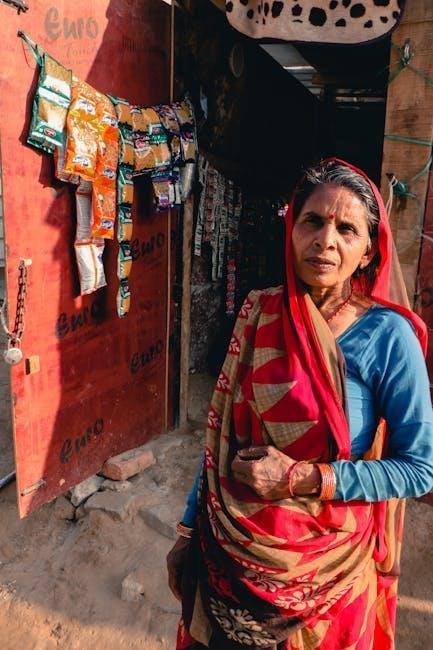
Indian bangles come in diverse designs, reflecting cultural richness. From kadas and choodas to lac and glass bangles, each type offers unique appeal. Styles range from intricate engravings to embellishments with gems, beads, or pearls, catering to varied tastes and traditions.
3.1 Different Types of Bangles
Indian bangles are categorized into various types based on design, material, and cultural significance. Kadas are thick, sturdy bangles, often made of metal, worn for their bold appeal. Choodas are sets of multiple bangles worn together, traditionally by married women. Lac bangles are crafted from natural resin and are known for their vibrant colors and flexibility. Glass bangles are delicate and come in intricate designs, often used in bridal jewelry. Metal bangles, including gold, silver, and brass, are timeless and versatile. Plastic and resin bangles offer a modern, lightweight alternative. Wooden and shell bangles add a natural, eco-friendly touch. Each type carries its own cultural and aesthetic value, making bangles a diverse accessory. These variations ensure there’s something for every preference and occasion.
3.2 Popular Styles and Designs
Indian bangles boast a wide array of popular styles and designs, reflecting cultural richness and contemporary trends. Intricate patterns, such as filigree work, floral designs, and geometric motifs, are highly sought after for their artistic appeal. Enamel finishes in vibrant hues like red, green, and gold are timeless favorites, often adorned with intricate detailing. Religious and spiritual motifs, featuring deities or sacred symbols, hold cultural significance and are popular during festivals. Contemporary designs, including minimalist patterns, abstract art, and fusion styles, cater to modern tastes. Stones and beads are frequently incorporated, adding a touch of glamour and versatility. Bridal bangles are often heavy, with elaborate craftsmanship, featuring pearls, crystals, or precious stones.
3.3 Bangles for Different Occasions
Indian bangles are versatile accessories that cater to various occasions, making them a must-have in every woman’s jewelry collection. Daily wear bangles are typically lightweight and simple, designed for everyday use. They are often made of materials like glass or metal and come in subtle designs. Festive and celebratory bangles, such as those worn during Diwali or Eid, are more elaborate, featuring bright colors and intricate patterns. Bridal bangles are a staple in wedding attire, often crafted with precious materials like gold and silver, and adorned with pearls, gems, or intricate engravings. Formal event bangles, such as those worn to parties or ceremonies, are statement pieces with bold designs and embellishments. Traditional occasions, like puja or cultural festivals, call for bangles that reflect regional craftsmanship, such as South Indian temple jewelry or North Indian kada styles. The choice of bangles depends on the event, ensuring they complement the outfit and enhance the overall look. This versatility makes bangles a timeless and essential part of Indian attire.
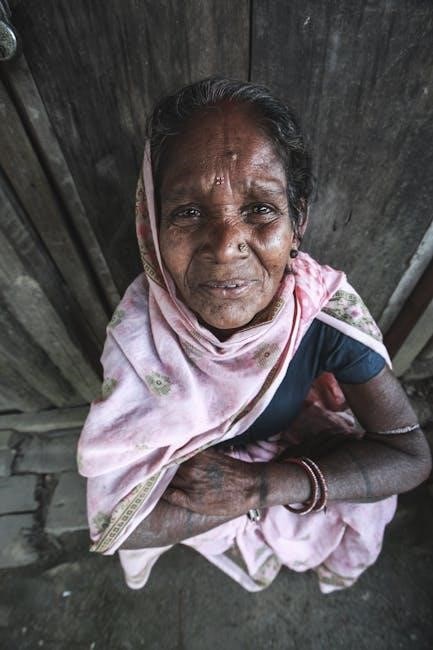
Materials and Craftsmanship
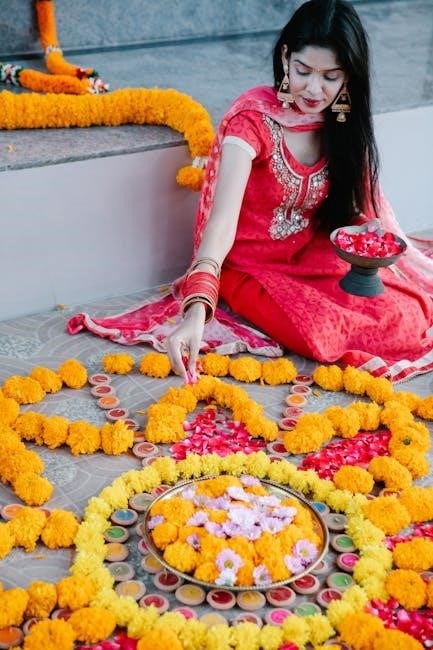
Indian bangles are crafted from diverse materials like gold, silver, glass, and lacquer. Artisans employ traditional techniques, ensuring intricate designs and durability. The craftsmanship reflects cultural heritage, blending modern trends with timeless artistry to create exquisite pieces.
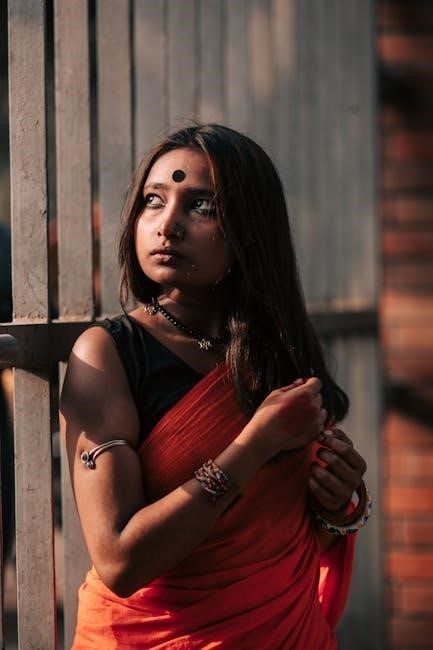
4.1 Common Materials Used in Indian Bangles
Indian bangles are crafted from a variety of materials, each with its own cultural and aesthetic significance. Gold and silver are popular choices, often adorned with intricate designs and gemstones. Glass bangles, known for their vibrant colors and delicate appeal, are widely worn during festivals and celebrations. Lacquer bangles, traditionally made in Hyderabad, are prized for their glossy finish and durability. Other materials include platinum, diamonds, and precious stones for luxury designs, while brass, copper, and terracotta are used for more rustic, traditional looks. Synthetic materials like plastic and resin are also gaining popularity for their lightweight and trendy designs. Each material offers a unique charm, catering to different preferences and occasions. The choice of material often reflects regional traditions, personal style, and the intended use of the bangle.
4.2 The Importance of Craftsmanship
Indian bangles are not just accessories but pieces of art, and their craftsmanship plays a pivotal role in their beauty and cultural significance. Skilled artisans invest immense time and effort into crafting bangles, ensuring precision and attention to detail. Traditional techniques, passed down through generations, are often employed, making each bangle unique and reflective of India’s rich heritage. The craftsmanship determines the quality, durability, and aesthetic appeal of the bangle, distinguishing it from mass-produced items.
A well-crafted bangle not only enhances the wearer’s appearance but also carries emotional and cultural value. Artisans carefully shape, mold, and embellish the materials, creating intricate designs that tell stories of tradition and creativity. The craftsmanship also ensures a comfortable fit, as bangles are designed to sit gracefully on the wrist. In many cases, bangles are custom-made, allowing artisans to tailor their work to individual preferences, further highlighting their skill and dedication. The artistry behind Indian bangles is a testament to the nation’s craftsmanship excellence, making them cherished possessions for generations.
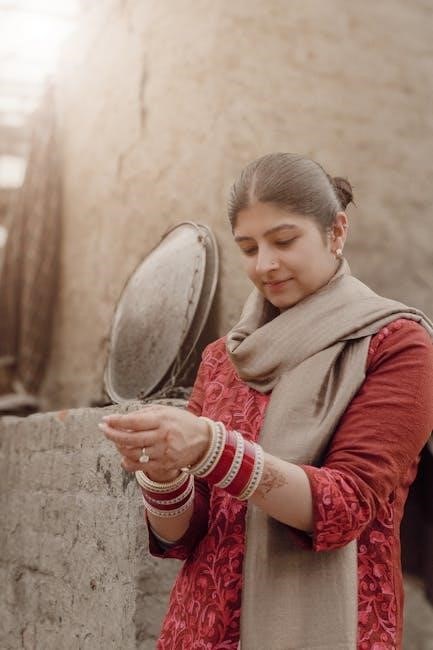
Regional Variations in Indian Bangles
Indian bangles showcase diverse regional styles, reflecting local culture and craftsmanship. Each region brings unique designs, materials, and traditions, creating a rich tapestry of bangle artistry that highlights India’s cultural diversity and artistic heritage through its intricate variations.
5.1 North Indian Bangle Styles
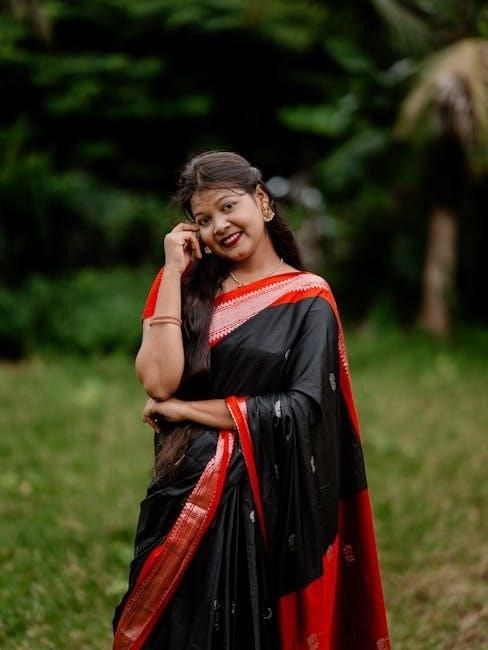
North Indian bangles are renowned for their intricate designs and craftsmanship, often reflecting the rich cultural heritage of the region. These bangles frequently feature elaborate patterns and embellishments, such as Kundan and Meena work, which are traditional techniques passed down through generations. The use of precious stones like diamonds, emeralds, and rubies is common, adding a touch of luxury and elegance.
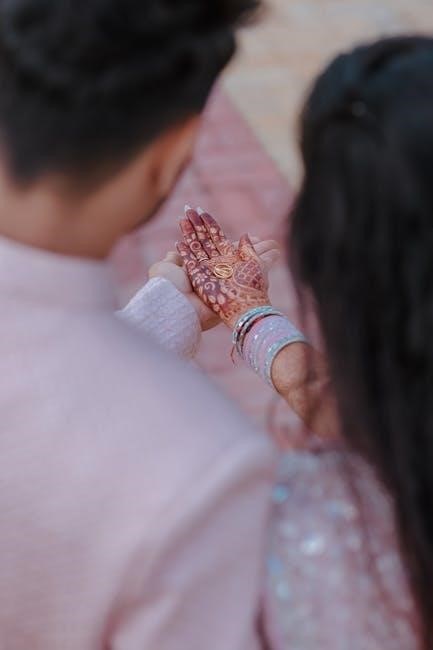
- Popular materials include gold, silver, and polished metals, which are often adorned with intricate filigree work.
- North Indian bangles are frequently worn during festivals, weddings, and other auspicious occasions, symbolizing prosperity and marital bliss.
- The designs often incorporate floral motifs and geometric patterns, blending traditional and contemporary aesthetics.
These bangles are not just accessories but also hold cultural significance, often passed down as heirlooms. The craftsmanship involved in creating North Indian bangles is unparalleled, making them a cherished part of Indian jewelry.
5.2 South Indian Bangle Styles
South Indian bangle styles are distinctive and deeply rooted in the region’s cultural and traditional practices. Known for their simplicity and elegance, these bangles often feature intricate gold and silver work, with designs inspired by nature and temple architecture. The use of precious stones like rubies, emeralds, and pearls is common, adding a touch of sophistication.
- A popular style is the “Nagercoil bangle,” hailing from Tamil Nadu, which is renowned for its gold and precious stone embellishments.
- Another prominent style is the “Kanyakumari bangle,” characterized by delicate filigree work and minimalistic designs.
- South Indian bangles often incorporate sacred symbols and motifs, reflecting the region’s spiritual and cultural heritage.
These bangles are frequently worn during weddings, religious ceremonies, and festivals, where they symbolize marital bliss and cultural identity. The craftsmanship in South India is highly regarded, with artisans spending hours perfecting each piece to ensure it meets the region’s high standards of beauty and tradition.
5.3 East Indian Bangle Styles
East Indian bangle styles are characterized by their unique blend of simplicity and cultural richness. The region, including states like West Bengal, Odisha, and Assam, is known for its tribal and traditional influences, which are reflected in bangle designs. These bangles often feature minimalist patterns, with an emphasis on natural materials such as silver, copper, and even bamboo or wood.
- One of the most iconic styles is the “Tribal bangle,” which is often adorned with intricate tribal motifs and patterns, symbolizing the wearer’s cultural identity.
- In Odisha, bangles are frequently designed with sacred geometric shapes and celestial motifs, inspired by the region’s rich temple art.
- Assamese bangles, known as “Galapatis,” are traditionally made from silver and feature delicate filigree work, often paired with small bells or beads.
East Indian bangles are not just ornaments but also carry deep cultural and symbolic meanings. They are often gifted during weddings and festivals, representing prosperity and good fortune. The craftsmanship in East India is highly regarded, with artisans preserving traditional techniques while incorporating modern designs to cater to diverse preferences.
